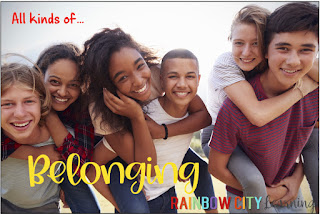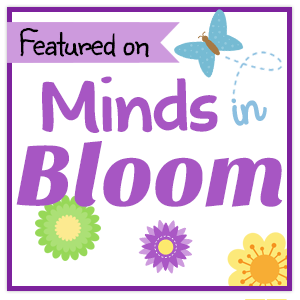You've been thinking about it, planning for it, and executing it for weeks now. Some of you have literally been working on it all summer. Your classroom. It's one of your sacred spaces. A space that is of high importance to you. It's not home. It's not the mall. Not the forest. Or the beach. It's a space in which the things that happen and the thoughts that you and your students have are very important to all of you. In your mind, the way you set up your classroom right now will set the tone for your entire school year.
Certainly prayer rituals in all religions can be considered as sacred space. To many of us, commuting time with our coffee in our cars is sacred space. Time spent with a pet, loved one, or special friend, can also be sacred space. Those few quiet minutes at the end of a teaching day after the busses have pulled away and the car pickup line has vanished can also be sacred space. You are sitting at your desk or table or even on the floor and no one has come through the door to talk with you. Yet. You know the time. Bet you can even recall how it feels right now!
Your classroom as sacred space. Sacred space is time and space we set aside to create a transition from our fast moving life. Morning Meeting can be an important part of that space. IMO it is a sacred space all on its own. It is a time to pause, to think, and to get in touch with our emotions. It's a time to grow and develop compassion and empathy as we listen to others. It's a time to develop confidence as we share ourselves and our own thoughts.
Morning meeting sends a clear message to all:
- We are not at home right now.
- We are not outside right now.
- We are in a space that is important to us as a community.
- We will learn and grow in this space.
- This is how we do things here.
This is how we do things here. Probably the most important message you will try to send to your students all year. It's the culture of your learning community. Having a Morning Meeting (or any variation of it that you are comfortable with) is an important part of building your classroom culture.
According to Responsive Classroom, Morning Meeting consists of four basic activities: greeting, sharing, group activity, and a message. It can take anywhere from fifteen minutes to a half hour. I really recommend using the full half hour in the early days until the "this is how we do things here" part of your class has been established. You can whittle it down as needed throughout the year. The time it takes can be adjusted through the sharing component. Create a system together with your students for deciding how many will share at a particular meeting and how the sharers will be selected. (Draw sticks, pass a ball or talking stick, drop name cards into a bucket, etc.) Some days you will have time for more sharing and even questions or comments about each story, and some days you won't. When it becomes "how we do things here", all variations will be accepted.
As you are setting up your classroom and deciding how to fit in all the academic components, it's important to consider how you will get the attention of your students for the the lessons and standards. If you've got a group that loves to talk, why not direct that in a positive direction, and give them something positive to talk about? Instead of fighting the talking, why not try a Morning Chat? I've written about something I tried in my own classroom called Morning Tweets. Kids came in and wrote what was on their minds. Those tweets could be used as the basis for sharing. While students are chatting or "tweeting", you can get all the housekeeping duties out of the way: lunch count, attendance, notes, etc. Find a specific piece of music that all will recognize as a transition to Morning Meeting time, and you shouldn't need to say a word. If introduced and practiced, kids should be able to come to your sacred space (Morning Meeting space) when they hear the music.
Greeting
I like to keep this part short and simple. My students would usually turn to the person on each side and hand shake, fist bump, or nod. They would say "Good morning!" to each other and say their name. You can get as fancy and/or silly with this part as you and your students agree on. We sometimes greeted each other in a language other than English, and sometimes as a Shakespearean character might have said it.
Sharing
My favorite way to choose who would share was by assigning a number to each student. I used calendar cards that already had numbers 1-30 printed on them. Students were assigned numbers (like their address, I told them!) at the beginning of the year, and added that number to all papers. It was also a good way to make sure that everyone had an equal chance of being called on. Choosing a few numbers to share each day will allow all who want to share a thought or a short story a chance to do so sometime during the week/two week cycle. As each shares, their number is then placed at the bottom of the stack of numbers.
Activity
This can be any whole group energizer that you think is fun and beneficial to your students. A dance move, a song, a poem to recite together are some ideas that we have tried. My newest idea is to use Morning Meeting Yoga as a way to include a short yoga practice (one pose and one breath) for the activity. It's short, sweet, and builds a practice that students can use throughout life as an emotional support tool. Adding a themed thought for the day can be in addition to or instead of the message. The thoughts in each set (Ten sets available in all!) will build character traits such as empathy, friendship, gratitude, kindness, caring, goal setting, collaboration, growth mindset, good character, and lifelong learning. The sets are interchangeable. Some contain a few partner poses to try as well!
Message
The message can be a simple thought for the day, or a longer message about what students will be learning that day. I recommend doing both. The yoga thought can be a silent meditation for kids to use through the day, and the academic message can be a great transition to the first lesson of the day.
Wishing you the best teaching year ever, and hoping that your classroom becomes a true sacred space this year for all who enter!
Click here for more Zen Classroom resources from Rainbow City Learning!
The fabulous bloggers of TEACHER TALK are back and blogging about the new school year. Follow us here on the third Sunday of each month throughout the year! This linkup is for our members only. If you'd like to join us, please email me at retta.london@gmail.com to find out how!




































